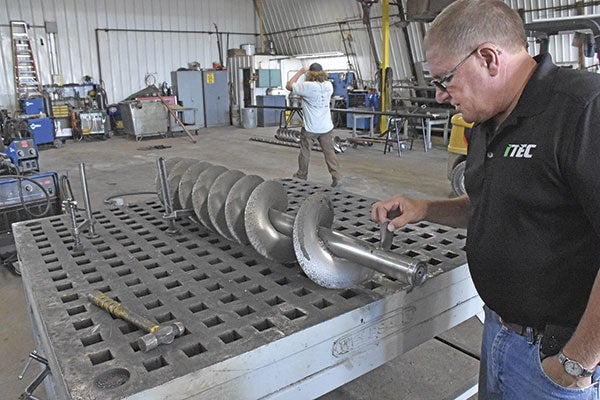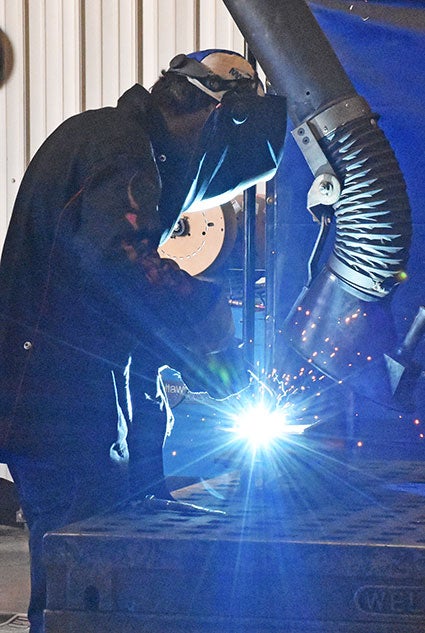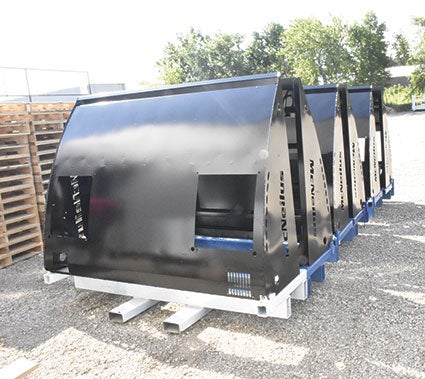Fabricating art one day, fixing a manure spreader the next
Published 6:00 am Thursday, August 31, 2017

- Metal Services of Blooming Prairie, Inc. President Dennis Heimerman, explains how corn wears down grain cart augers. Christopher Baldus/chris.baldus@austindailyherald.com
Metal Services of Blooming Prairie, Inc. sprouted out of an agricultural repair shop
BLOOMING PRAIRIE — It’s Monday at the repair shop, a yellow metal building on the northeast end of town.
Outside are a pair of gravel trailers — one with a rebuilt rear base and the other with an end gate re-engineered to swing two ways. A grain cart that’s waiting for its rebuilt auger is nearby. So is the steelwork for a bridge.
“I can’t visualize artwork, but I can visualize bridges,” says Dennis Heimerman, president of Metal Services of Blooming Prairie, Inc. “So, I occasionally build one.”
Artists will come to his business to have metal crafted for their visions. That kind of work is done at the repair shop’s sister facility just up the road.
The metal fabrication plant built 11 years ago is the repair shop’s big sister in size, equipment and workload. Metal Services has more than 300 other businesses as customers. On this day, the plant is producing canopies and lift arms for McNielus Companies garbage trucks. Precision laser and plasma cutting is involved, as is metal bending and welding. Technicians also use a tool the size of a double garage door to squeeze a punch that pops holes in steel that’s inches thick.
While the repair shop does a much smaller percentage of Metal Services business, it is the foundational piece. It’s where Heimerman started the company back in 1984, during the farm crisis. He thought he would simply be in the ag repair business.

A production welder works on a project at Metal Service of Blooming Prairie, Inc. The duct work above his project vacuums up fine particles so the welder doesn’t inhale them.
Christopher Baldus/chris.baldus@austindailyherald.com
Getting started
“The first winter, things got a little slim because people weren’t spending money,” Heimerman said in a conference room at the fabrication plant prior to the tour of the repair shop. “I mean, I had a little shop with some low overhead, but it was going to be tough.”
So, he launched plan B.
“I just pounded on the doors and wrote letters to all the factories in the area,” he said.
He amassed a list of clients and eventually subcontract work began coming his way.
“Some of those factories relied on their maintenance people to do the building of carts and racks and all that stuff,” Heimerman said. “They were growing so fast that they couldn’t keep up with it either, and they needed their guys to stay on maintenance.”
His shop began to do a lot of fabrication work for for Owatonna factories, eventually linking up with McNielus Companies.
“That’s our major customer today,” he said.
Common repairs
“Let’s see what kinds of things they are working on today,” Heimerman adds as he enters the repair shop.
The outside grain cart’s auger is on one of the work tables. The blade that curls around the center shaft has been beaten thinner in places than a knife.
“Corn wears augers out,” he says. “You can see how thin this is right here. You could shave with it.”
He runs his hand over dents in the metal. “All this you see is worn from the corn,” he says. “Corn is fairly abrasive and, of course, they are moving a lot of it fast.”
One of the three men who make up the repair shop’s crew will be removing the auger’s twisting blade, which Heimerman calls a “flight.”
“We do a lot of these,” he says. His farm customers don’t have to “replace that whole
shaft, which is really expensive to replace the whole shaft from a dealer. We can just cut off that flighting and put new back on.”
He looks to a square water tub at the back of the shop.
“Hey, Seth, what are we doing here?”
Seth Petranek, repair technician, answers: “That’s the front end off of a John Deere tractor.”
Part of it broke and parts of it that should slide were stuck.
“It’s all froze together and it didn’t matter how much we’d heat it or pulled on it it wouldn’t move,” Seth says.
Repair shop manager Harvey Farr told his crew to soak “it in a tub of water for a couple weeks … to get all the dirt loosened up that may be dried up and caked in there,” Petranek said.
They’ve done it before.

Canopies for the cabs of garbage trucks sit outside the Metal Services of Blooming Prairie, Inc. fabrication plant. Christopher Baldus/chris.baldus@austindailyherald.com
Busier days ahead
The repair shop expects to be busier as the harvest nears. Farmers will be done assessing their equipment needs soon and will order repairs so their field work goes uninterrupted by mechanical failure, Heimerman said.
Metal Services has two large trucks outfitted with welders and tools necessary to head out to the fields to make repairs, however.
The variety of repairs seems boundless.
“They will bring in anything from a part of a planter to part of a digger to livestock equipment, trailers,” Heimerman said.
“Just about anything goes through down there … if it needs a part fabricated we’ll fabricate (it at the plant). They will also build a lot of stuff new, whatever is needed for the job.
“These guys up here (in the plant) are working off blue prints from somebody’s factory or that somebody drew here… These guys are production welders, those guys (at the shop) are ,well, a little different mindset.”
A Fabricator
Metal Services is not a machine shop, although it can do some of those functions. Most of the time, the business will contract that out.
“A machine shop has machines that turn and mill,” Heimerman said. “So you’re turning shaves and shapes and your spinning. Where a fabricator, we’re cutting flat sheets and bar stocks and bending it and punching holes and making them into parts.”
The fabrication plant is a key service for companies practicing lean manufacturing. Metal Service makes items they need in smaller amounts so they don’t need to store the extras. An advantage to that is avoiding how time and other factors can damage those stored parts.
McNielus, for example, used to have to clean off the rust from replacement handrails before putting them on trucks, Heimerman said. By having Metal Service make them only when needed, that cuts down on cost for McNielus.
“We deliver parts as they want them rather than (them) ordering big stocks ,” he said.
Farmers and the repair shop also use the fabrication services.
“We do a lot of work up here too for the ag market,” Heimerman said. “Some just gets cut and sent down to those guys (in the repair shop).”
The plant also has done work with artists.
“We are a little different than some shops in that we will do one piece for somebody,” Heimerman said.
“We’ve got a couple of pieces of art out there with an artist. One is sitting at the Gustavus Adolphus campus in St. Peter,” he said, adding that the other is in front of a Twin Cities metro area library.
“So we’ll get special stuff that’s kind of fun you don’t generally get. We might be doing a manure spreader one day or we might be doing something challenging… This guy will come with an artist’s conception and says, ‘This is what I’m trying to build,’ and we’ll help him try to determine what kind of materials he needs to create what he’s after.”
The bridge
The afternoon sun reflects off the black gloss covering Hermerman’s latest metalwork behind the grain cart. It has an easy curve, presumably for the bridge deck.
Hiemerman, who doesn’t visualize art, but he visualizes scenery.
“That’s for going across a creek,” he says.





